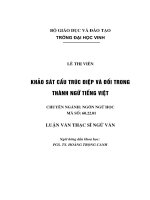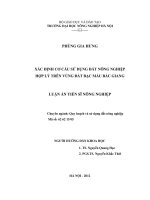Mẫu câu viết luận văn
Bạn đang xem bản rút gọn của tài liệu. Xem và tải ngay bản đầy đủ của tài liệu tại đây (82.14 KB, 4 trang )
5.1.
Not to
say nothing of
That
is mention/to
to say
Cáchdùng:“That
dùng: “Not is”
to mention"
sayđược
nothing
or được
dùng cấp
đề thêm
nhấn
mạnh.
Cách
và “that isvà
to“to
say"
sử dụng
để cung
thêmthông
thôngtin
tinvới
chiýtiết,
làm
rõ ý muốn nói. Ví
Ví
dụ:
“The
war
caused
unprecedented
suffering
to
millions
of
people,
not
to
mention
its
impact
on the
dụ: “Whales are mammals. That is to say, they must breathe air."
country’s economy."
6. Notwithstanding
2. In
other
words
Cách dùng:
cách
nôi khác
của “nonetheless”.
Cách
dùng: sử dụng “inthe
other
words"khi
bạnmethodology
muốn diễn tàused,
điều nào
đóan
theo
một cách
khác
giàn hơn, làm
Ví
dụ: “Notwithstanding
limitations
of the
it was
important
study
in đơn
the development
đọcview
dễ hiểu
hơn.
ofngười
how we
the workings
of the human mind."
Ví dụ: “Frogs are amphibians. In other words, they live on the land and in the water."
7.
In view of/in light of
3. To
put
another
Cách dùng:
được
dùngitkhi
nói về điều way
gì đó đã được chứng minh rõ ràng, được soi sáng Ví
Cách
này là cách
“in we
other
words"
dụ:
“In dùng:
light ofcụm
the từ
evidence
from nói
the khác
2013 của
study,
have
a better understanding of...”
Ví dụ: “Plants rely on photosynthesis. To put it another way, they will die without the sun."
8. To that end
4. Persuasive
Cách dùng:
“to that end” hoặc “to this end” được dùng tương tự như “in order to” hoặc “so”.
Cách
dùng have
đề tổng
kếtsought
lại những
tranh luận mà
bạn
tin là có
sức thuyết phục
Ví
dụ: dùng:
“Zoologists
long
to understand
how
animals
communicate
with nhất.
each other. To that end, a
Ví dụ:
“Scholar
A’s launched
point - that
Constanze
Mozart was
motivated
bypossible
financialmeanings.”
gain - seems to me to be the
new
study
has been
that
looks at elephant
sounds
and their
most persuasive argument for her actions following Mozart's death."
9.
All things considered
Cách dùng: có nghĩa là “taking everything into account": mọi thứ đả được rõ ràng, như một lẽ đương nhiên. Ví
dụ: “All things considered, it seems reasonable to assume that..."
10.
Another key thing to remember
Cách dùng: dùng cụm “another key point to remember" hoặc “another key fact to remember" đề thay cho từ
IẴ
also".
Ví dụ: “As a Romantic, Blake was a proponent of a closer relationship between humans and nature. Another
key point to remember is that Blake was writing during the Industrial Revolution, which had a major impact on
the world around him. ”
11.
Moreover
Cách dùng: sử dụng “moreover" ờ đầu câu để báo hiệu rằng bạn đang muốn thêm thông tin cho quan điềm của
mình.
Ví dụ: “Moreover, the results of a recent piece of research provide compelling evidence in support of..."
12.
Furthermore
Cách dùng: giống như “moreover".
Ví dụ: “Furthermore, there is evidence to suggest that..."
25.
contrast/in
comparison
21.
Coupled
withthat
17.
Having
said
13.By
What’s
more
Cách
“by
contrast"
hoặc
“inor
comparison"
khi
bạn
dangtạisocùng
sánhmột
2 thứ
ngược nhau.
Cách
dùng:
sử
dụng
khi
cân
nhắc
giữa
2 “but"
hoặcor
nhiều
hơn
ý kiến
thờiđối
điểm.
giống
“on
the
other
hand"
“however".
Cáchdùng:
dùng:dùng
giống
như
“moreover”
và
“furthermore".
Ví
A's
then,
is
based
onstatistics
insufficient
Bythat
contrast,
Scholar
B's opinion
dụ:“Coupled
withopinion,
the
literary
evidence,
paint
a this
compelling
view
of...”
Ví
dụ:
“The historians
are
unanimous
in the
telling
US X,
an evidence.
agreement
suggests
that this
version seems
of events
Vỉdụ:
dụ:“Scholar
“What’s
more,
this
isn’t
the
only
evidence
that
supports
hypothesis.’’
more
must plausible.”
be an accurate account. Having said that, the archaeology tells a different story."
22.
order to
14. In
Likewise
26.
Then
again
Cách
dùng:
In
order
to"
đượckhi
sửbạn
dụng
để nói
đích
nào đó
cần phải
Ví cập.
18.
Firstly,
secondly,
thirdly...
Cách
dùng:
dùng
“likewise"
muốn
nóivề
vềmột
điềumục
gì đó
tuxyng
tự như
điều đạt
bạnđược
vừa đề
Cách
dùng:
được
nhấn
mạnh,
lạithứ
chắc
chắn một lầninnữa
điềuofđã
khẳng
trước đó.
dụ:
“In
order
to understand
X,đến
we
need
first
tođịnh
understand
Y."
Cách
dùng:
Dùng
để
đềđểcập
các
ý khẳng
cần
nói
theo
tự.compellingly
Ví dụ:
“Scholar
Adùng
believes
X.
Likewise,
Scholar
B argues
favour
this
pointđịnh
of view."
Ví
asserts
thisinwas
the reason
what
happened.
Then again,
possible
Vídụ:
dụ:“Writer
“There Aare
manythat
points
support
of this for
view.
Firstly,
X. Secondly,
Y. And It’s
thirdly,
z. that he was being
15.
To
paid to23.
sayHowever
this.”give an
illustration
Cách
dùng:
dùng
“however"để
nói về điều trái ngược lại với ý phía trước.
As
well
Cách19.
dùng:
giống
“for as
Instance"
27.
Ví
"Scholar
A said
thinks
this.
Scholar
B“and”.
reached
a different
conclusion."
Cách
dùng:
dùng
“as
well
as"However,
thay
VÌ “also"
hoặc
Vi dụ:
dụ:
“ToThat
give
an
illustration
of
what
I mean,
let’s
look at the
case of..."
Cách
dùng
again”.
Vi dụ:dùng:
“Scholar
A gióng
arguednhư
that“then
this was
due to X, as well as Y.”
theostensibly
other hand
16.
Similarly
Ví dụ:24.
“TheOn
evidence
appears to point to this conclusion. That said, much of the evidence is unreliable
Cách
dùng:
Cách
dùng
tương
tự “however”
20.
Not
but
also
Cách
dùng:
dùngonly...
“similarly"
gióng
như “likewise”.
at
best.”
Vi
“The
historical
evidence
appears
tođể
suggest
a clear-cut
situation.
On the
other hand,
thevery
archaeological
Cách
cấu trúcatcâu
dùng
thêm một
phần thông
tin, thông
thường
làitnhững
điều
sẽ gây to
Vídụ:
dụ:dùng:
“Audiences
the này
timeđược
reacted
with
shock
to
Beethoven’s
new
work,
because
was
different
evidence
presents
a hơn
somewhat
less
picture
of what
ngạc
nhiên,
bất ngờ
thông
tinhave
ở phần
truớc.
what28.
theyYet
were
used
to. phần
Similarly,
westraightforward
a tendency
to react
withhappened
surprise tothat
theday."
unfamiliar. ’’
Cách
khi Edmund
bạn muốnHillary
nói vềhave
ý kiến
ngượcofnhau.
Ví dụ:dùng:
“Not dùng
only did
thetrái
honour
being the first to reach the summit of Everest, but he
Ví
dụ:also
“Much
of scholarship
has focused of
onthe
thisOrder
evidence.
not everyone
was
appointed
Knight Commander
of theYet
British
Empire." agrees that this is the most
important aspect of the situation.”
37. Importantly
29. Despite
this
33.
Cách Nevertheless
dùng: “importantly" có thề được thay thế cho “significantly" mà không làm thay đồi ý cùa câu.
Cách dùng: “despite this” hoặc “in spite of this" có nghĩa là “mặc dù, cho dù, dẫu rằng”.
Cách Ví
dùng:
tuxyng tự Scholar
“nonetheless”.
dụ: “Importantly,
A was being employed by X when he wrote this work, and was presumably therefore
Ví dụ: “The sample size was small, but the results were important despite this. ”
under
pressure
to
portray
the
more
favourablynevertheless.”
than he perhaps might otherwise have done. ”
Ví dụ: “The study was flawed, situation
but it was
important
30. With
in mind
38. Inthis
conclusion
34.
For instance
Cách dùng: tổng kết lại toàn bài, đứng đầu cáu.
Cách dùng: dùng khi bạn muốn người đọc tự vận dụng kiến thức của cá nhân đề hiểu vấn đề.
Cách Vi
dùng:
gióng
“for example”
dụ: “In
conclusion,
evidence points almost exclusively to Argument A."
Ví dụ: “We've
seen thatthe
the
methods used in the 19th century study did not always live up to the
Vỉ dụ: “Some birds migrate to avoid harsher winter climates. Swallows, for instance, leave the UK in
rigorous standards
expected
39. Above
all in scientific research today, which makes it difficult to draw deTmite
early winter and fly south...”
Cách dùng:
dược
dùng
đề báo let’s
hiệu rằng
gi mà bạn
nói sau
đây to
sẽ see
là ý chính
bài. compare."
conclusions.
With
this
in mind,
looknhững
at a more
recent
study
how của
thetoàn
results
Vi dụ: “Above all, it seems pertinent to remember that...”
35.
31.
Significantly
Provided that
Compelling
Cách dùng:40.
dùng
để nói về một điều gì đó có ý nghĩa đặc biệt, nhấn mạnh.
Cách Cách
dùng:
nó có nghĩa tương tự “on condition that” (với điều kiện là). Bạn có thể sử dụng
dùng: tuowgn tự “persuasive"
Ví dụ: “Significantly, Tacitus omits to tell US the kind of gossip prevalent in Suetonius’ accounts of the
“providing”
VỚImost
ý nghĩa
tươngargument
tự
Vi dụ: “The
compelling
is presented by Scholar A."
32.
Nonetheless
Notably
same36.
period.
Ví dụ: “We
may use this as evidence to support our argument, provided that we bear in mind the
Cách dùng: tuợng
tuxyngtự
tự“despite
“especially,
this”.markedly"
limitations of the methods used to obtain it."
Ví dụ: “Actual
“The study
figures
hadare
its limitations,
notably absent
but Itfrom
wasScholar
nonetheless
A's analysis.
groundbreaking for its day.









